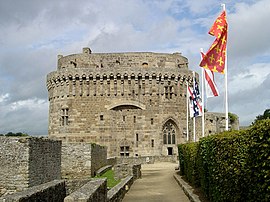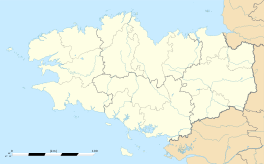Dinan
| Dinan | ||
|---|---|---|

|
||
|
||
| Coordinates: 48°27′23″N 2°02′56″W / 48.4564°N 2.0489°WCoordinates: 48°27′23″N 2°02′56″W / 48.4564°N 2.0489°W | ||
| Country | France | |
| Region | Brittany | |
| Department | Côtes-d'Armor | |
| Arrondissement | Dinan | |
| Intercommunality | Dinan | |
| Government | ||
| • Mayor (2014–2020) | Didier Lechien | |
| Area1 | 3.98 km2 (1.54 sq mi) | |
| Population (2008)2 | 10,953 | |
| • Density | 2,800/km2 (7,100/sq mi) | |
| Time zone | CET (UTC+1) | |
| • Summer (DST) | CEST (UTC+2) | |
| INSEE/Postal code | 22050 / 22100 | |
| Elevation | 7–92 m (23–302 ft) | |
|
1 French Land Register data, which excludes lakes, ponds, glaciers > 1 km² (0.386 sq mi or 247 acres) and river estuaries. 2Population without double counting: residents of multiple communes (e.g., students and military personnel) only counted once. |
||
1 French Land Register data, which excludes lakes, ponds, glaciers > 1 km² (0.386 sq mi or 247 acres) and river estuaries.
Dinan (French: [di.nɑ̃]) is a walled Breton town and a commune in the Côtes-d'Armor department in northwestern France.
Its geographical setting is exceptional. Instead of nestling on the valley floor like Morlaix, most urban development has been on the hillside, overlooking the river Rance. The area alongside the River Rance is known as the port of Dinan and is connected to the town by the steep streets Rue Jerzual and its continuation outside the walls the Rue de Petit Fort. This river has moderate turbidity and its brownish water is somewhat low in velocity due to the slight gradient of the watercourse; pH levels have been measured at 8.13 within the city of Dinan and electrical conductivity of the waters have tested at 33 micro-siemens per centimetre. In the centre of Dinan the Rance summer flows are typically in the range of 500 cubic feet per second (14 m3/s).
For many years, the bridge over the River Rance at Dinan was the most northerly crossing point on the river, but the tidal power station at the mouth of the estuary, constructed in the 1960s downstream from Dinan, incorporates a 750 metre long tidal barrage which doubles as a crossing point nearer to the sea.
Inhabitants of Dinan are called dinannais and dinannaises.
The medieval town on the hilltop has many fine old buildings, some of which date from the 13th century. The town retains a large section of the city walls, part of which can be walked round.
Major historical attractions include the Jacobins Theatre dating from 1224, the flamboyant Gothic St Malo's Church, the Romanesque St Saviour's Basilica, Duchess Anne's Tower and the Château de Dinan.
...
Wikipedia



